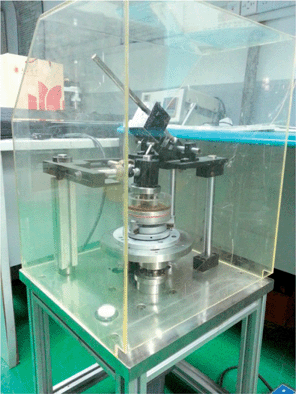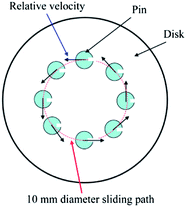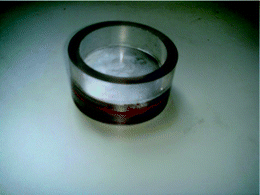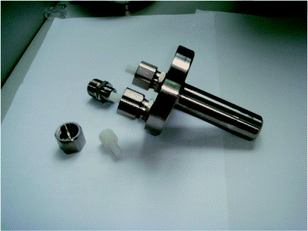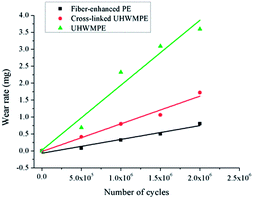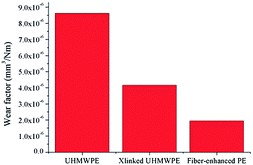Development of a BiotriboPOD testing methodology for the wear evaluation of orthopaedic biomaterials
Zikai Hua*a,
Huanhuan Zhanga,
Yongwei Fana and
Zhongmin Jinbc
aSchool of Mechatronics Engineering and Automation, Shanghai University, No. 149, Yanchang Rd, 200072 Shanghai, China. E-mail: zikai_hua@shu.edu.cn; Fax: +86 5633 1517; Tel: +86 5633 1517
bSchool of Mechanical Engineering, Xi'an Jiaotong University, PR China
cSchool of Mechanical Engineering, University of Leeds, UK
First published on 17th April 2014
Abstract
Biotribological properties of orthopaedic biomaterials have significant influence on the wear performance of implants, and the bench wear evaluation of orthopaedic biomaterials is regarded as an important testing methodology. In this study, a 3-station Biotribo-POD apparatus was developed for the wear tests of orthopaedic biomaterials. Validation tests were carried out by using conventional ultra high molecular weight polyethylene (UHMWPE), cross-linked UHMWPE and Fiber-enhanced polyethylene (Fiber-enhanced PE) pins sliding against CoCrMo disks. The performances of the BiotriboPOD apparatus together with the testing methodology are discussed. Results show that the Biotribo-POD apparatus can provide an efficient, reliable and economic methodology for the wear evaluation of orthopaedic biomaterials.
Introduction
Wear has been recognized as the key factor affecting the long-term performance of orthopaedic implants such as hip, knee and spine prostheses.1 The tribological evaluation of orthopaedic implants and materials has become an essential testing procedure to determine the amount of material removal for a specified duration under body-simulated conditions. Since material selection and component design are two important factors in the wear performance and durability of orthopaedic implants, both biomaterial and product wear tests are needed.Joint simulators, such as hip and knee joint simulators, have been developed to simulate the biomechanics of human joints and served as product-level wear tests for artificial joints. Results obtained from these tests showed similar wear rates and particle morphologies as observed in vivo experience.2–5 Thus, several simulator wear tests have been standardized on the wear testing of joint prostheses by ISO organization.6–8 But most of the simulator wear tests are established for the prosthetic products as an overall test for specific design and material combinations.
Because the tribological property of orthopaedic biomaterials has significant influence on the wear performance of implants, the bench wear evaluation of orthopaedic biomaterials is regarded as another important testing methodology. A proper bench wear test can be used to develop an understanding of wear mechanisms and the influence of environmental, design, and material parameters on wear behaviour.9–12 Moreover, due to the low productivity, complex structure and high cost of joint simulator wear testing, a reliable and effective wear testing methodology for orthopaedic biomaterials is expected and required.
Pin-on-disk (POD) test is a common testing methodology for determining the wear of materials during sliding. In such tests, a pin with a radiused tip or a ball rigidly held, is positioned perpendicular to the other, usually a flat circular disk. And the test machine, pin-on-disk testing apparatus, causes either the disk specimen or the pin specimen to revolve about the disk center. Due to its advantages in material wear testing, such as easy operation, simple specimen shape and low cost, pin-on-disk test has been standardized in ASTM G99 (ref. 13) and wildly used in material wear characterizations. In the tribological evaluation of orthopaedic implants, POD testing methods have also been applied. However, unfortunately, the conventional POD test devices with unidirectional relative motions between a pin and a disk could not reproduce the wear factors obtained in clinic. For example, the wear factors obtained for the most common combination, ultra high molecular weight polyethylene (UHMWPE) against polished CoCrMo alloy in bovine serum are of the order of 10−8 mm3 N−1 m−1 whereas the true clinical wear factors measured from retrieved acetabular cups of artificial hip joints are of the order of 10−6 mm3 N−1 m−1.14,15
According to the study on the joint movements in human activities, researchers have observed a directional dependence on the wear rate of orthopaedic biomaterials.16,17 Thus, the multi-directional motion has been regarded as fundamental importance in laboratory wear tests for orthopaedic biomaterials. Following this rule, studies on the development of new POD devices for orthopaedic biomaterials are being carried out. Saikko18 developed a high-capacity hip wear simulator of the circular translation pin-on-disk type, call super-CTPOD, which could provided 100 separated test stations and reproduced the wear of artificial hip joints in vitro. The present authors designed a single-station POD apparatus, and validation test results show the wear factor agreed with those obtained in clinic.14 Recently, study on different friction traces of multi-directional sliding paths also lead to the development of multi-directional tribometer19 and RandomPOD.20
Although several new POD devices have been designed and built, it still requires more validation and characterization of such kind of multi-directional wear testing methods for the orthopaedic biomaterials. In this study, a 3-station Biotribo-POD apparatus was developed based on the previous circular translation POD device. Validation tests were carried out by using conventional ultra high molecular polyethylene (UHMWPE), cross-linked UHMWPE and Fiber-enhanced polyethylene (Fiber-enhanced PE) pins sliding against CoCrMo disks via this apparatus.
Material and methods
BiotriboPOD description
The 3-station BiotriboPOD (Fig. 1) was developed and modified from a single-station POD device.14 The base, loading arrangement, motor and cover was the same. The multi-directional sliding track was generated by a motion module of BiotriboPOD. In this module, a motion plate was supported by a crank with identical 5 mm eccentricity and two stacked linear bearings in XY direction. Driven by an electric motor, the crank formed a circular sliding track between the pin and the disk. In detail, the pin did a revolution on the disk along a track of 10 mm diameter. The disk was clamped by the chuck, hence no relative rotation occurred between the pin and the disk. The direction of the relative velocity changed simultaneously during the sliding, as shown in Fig. 2. One cycle was one complete revolution of the direction of sliding. Therefore, the multidirectional motion could be generated. Moreover, a piece of polyvinyl chloride (PVC) tube formed a lubricant brim, which was fixed to the disk with a silicone O-ring (Fig. 3). A flexible silicone coated heater with P type thermal couple was attached on the brim for temperature control of the lubricants. Three pin stations assembled in the pin guiding module were located above the disk, and vertically loaded against it.Experimental procedure
Three kinds of pins were tested in the study, which were made of conventional ultra high molecular polyethylene (UHMWPE), cross-linked UHMWPE and Fiber-enhanced polyethylene (Fiber-enhanced PE). The diameter of the pins was 10 mm, but the initial diameter of the wear face was chambered to 3 mm with an average surface roughness of 0.1 μm. These pins were mounted into a rigid sample holder and rotation was prevented by a setscrew (Fig. 4). CoCrMo alloy disks were used in the experiments, which were 80 mm in diameter and 25 mm in thickness. The wear surfaces of the disks were machined, ground and diamond-polished. The surface roughness was between 0.01 and 0.02 μm, measured by a diamond stylus profilemeter. All the tests were done at room temperature which was 20 °C on the average.All the samples were pre-cleaned with medical alcohol, and then ultrasonically cleaned for 30 min. The angular velocity of the disk was 6.28 rad s−1 (corresponding a frequency of 1 Hz), resulting as sliding distance of 31.4 mm per cycle and a constant sliding speed of 31.4 mm s−1, which is between the mean and the maximum sliding speeds during a human walking cycle.21 The load was static 7 N on the pin, and the nominal contact pressure was 1 MPa. The lubricant used in the experiments was Alpha Calf Fraction serum by Gibco Co. Ltd. And the lubricant was diluted 1![[thin space (1/6-em)]](https://www.rsc.org/images/entities/char_2009.gif) :
:![[thin space (1/6-em)]](https://www.rsc.org/images/entities/char_2009.gif) 1 with Milli-Q-grade distilled water, and filtered through a 1 μm filter paper according to the requirements on the fluid test medium in ISO 1424X standards.6–8
1 with Milli-Q-grade distilled water, and filtered through a 1 μm filter paper according to the requirements on the fluid test medium in ISO 1424X standards.6–8
Three tests were preformed by different wear couples and a total 2 million cycles was run for each test. The amount of wear was measured by weight loss method. Every 50 million cycles the specimens were weighed for gravimetric wear using a Satorius TG328B balance with a resolution of 0.01 mg. During a weigh stop, the specimens, pin holders and lubricant chambers were carefully cleaned. After the weighing, the specimens were reassembled, and the test was continued with fresh lubricant. Soak control specimens were used to correct for fluid absorption. And the calculation of the gravimetric wear was referring to ISO 14242 standard (eqn (1)).8 Each test had 0.2 million running cycles in advance. And the wear surfaces were examined using a Leica optical microscope.
| Wn = Wan + Sn | (1) |
Results
All the tests were uneventful. After 6.6 million cycles the BiotriboPOD could run smoothly. Wear rates observed in the tests were linear fitted and summarized in Fig. 5. The correlation coefficients of linear regression of the mean weight loss values were 0.95534 (Fiber-enhanced PE), 0.97405 (Xlinked UHMWPE) and 0.95333 (UHMWPE). The general trends regarding wear rates were as follow. The wear rate of the Fiber-enhanced PE pins was the lowest, and the wear rate of cross-linked UHMWPE pins was lower than the conventional UHMWPE. The slopes of the linear regression were 0.407 mg/106 of Fiber-enhanced PE, 0.817 mg/106 of cross-linked UHMWPE and 1.92 mg/106 of UHMWPE. Meanwhile, the wear factor was also calculated so that wear rate was divided by 2 × 106 × 0.94 mg mm−3 × 7 N × 0.0314 m (Fig. 6), since wear factor is a useful quantity for the comparisons with in vitro and in vivo wear measurements. The wear surface morphologies of the pins were shown in Fig. 7. All wear surfaces seemed to be highly burnished. Microscopy showed a featureless, flat topography in every pin with some criss-cross scratches. The disks were not damaged, only some circular scratches were observed.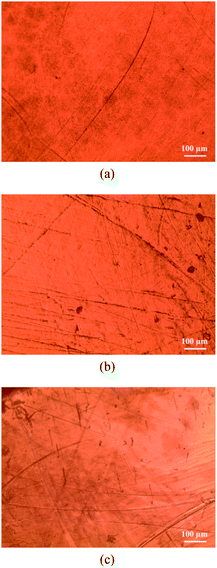 | ||
| Fig. 7 Optical micrographs of the pin wear surfaces after 2 million cycles (a) UHMWPE, (b) Cross-linked UHMWPE, (c) Fiber-enhanced PE. | ||
Discussion
The tribological property of orthopaedic biomaterials has significant influence on the wear performance of implants. A reliable and effective wear validation and investigation testing methodology for orthopaedic biomaterials can be used to develop an understanding of wear mechanisms and the influence of environmental, design, and material parameters on wear behaviour. In this study, a BiotriboPOD apparatus together with its performance were introduced and analyzed. In validation tests, the testing methodology was also discussed.Generally, the basic duration of one wear test for orthopaedic implants, i.e. hip or knee prostheses, should be no less than 5 millions cycles. Hence, the reliability of the wear testing equipments is an important factor. In this study, the apparatus remained in good operation condition after 6.6 million testing cycles, which indicated the design met the long term reliability requirement. Since this testing method is developed and modified upon the standard POD wear tests, it still reserves the advantages on quickly and reliably identifying those low-friction, low-wear materials for which the more expensive and time-consuming joint simulator testing is justified. In addition, this pin-on-disk test can be used to relate wear to material parameters such as polymer molecular weight or counterface surface finish, on a more practical basis than is possible in joint simulator tests.
In retrieval analysis of artificial joints, the clinical wear factors are of the order of 10−6 mm3 N−1 m−1.22 In this study, the wear factors of UHMWPE (8.62 × 10−6 mm3 N−1 m−1) and cross-linked UHMWPE (4.16 × 10−6 mm3 N−1 m−1) (Fig. 6), which are within the range of clinical wear factors. This present results also confirmed the importance of multi-directional motion in the wear simulation of orthopaedic biomaterials, whereas the wear factor of UHMWPE pins obtained in unidirectional wear tests were of the order of 10−8 mm3 N−1 m−1.23 The main explanation of divergency is the multi-directional pattern of movement resulting in a cross-shear stress on the wear couples.24,25 However, in wear testing methodology of orthopaedic biomaterials, ASTM published a standard on the wear tests of polymer materials used in total joint prostheses, in which, multi-directional wear tests were mentioned only in fixed-bearing ball-cup wear application and little information was described on the types of relative motion.26 In the analysis of relative motions, Korduba et al.23 used rectangular sliding tracks to simulate the cross-shear effect in orthopaedic implants and found the aspect ratio of the rectangle had a significant effect on the wear of UHMWPE. Dunn et al.19 investigated the in situ friction coefficient over relevant motion paths and found friction coefficient was affected by changes of curvature in the motion path. In this study, circular sliding track has been chosen as the motion path, hence the direction of sliding velocity changed continuously during each cycle. Since there was no linear motion occurred during the experiments, higher wear rates could be obtained due to the continuous cross shear stresses.
In Fig. 7a, the wear surfaces of conventional UHMWPE were highly burnished, which were typical observations with multi-directional motion and protein-containing lubricants. The surfaces of cross-linked UHMWPE (Fig. 7b) and Fiber-enhanced PE (Fig. 7c) were not as well burnished as those of conventional UHMWPE, and some cross scratches caused can be found. This means that less material has been removed in these two specimens referring to their lower wear rates. This finding also indicates that the wear mechanisms of the specimens are adhesive polish or burnish caused by the cross shear produced in the multi-directional relative motion between the wear couples, which is detrimental to the wear behavior of polyethylene orthopaedic components in clinic. On the contrary, the unidirectional linear movement pattern provokes an orientation of the molecular chains in the polymer material which results in a strain hardening effect of the polyethylene.27,28
The dependence of wear rates of all the tested specimens on the number of cycles is highly linear (Fig. 5), which means that by using this testing methodology a well prediction of the wear can be achieved. The correlation coefficients of linear regression close to unity prove strict control in the tests. And since the wear is linear, the concept of wear rate can be used in the comparison of materials. In wear testing of orthopaedic biomaterials, an important requirement of a suitable method for a reliable investigation or validation has to be the ability to distinguish between design concepts and allow for a direct comparison of predicate biomaterials. The results obtained in the validation tests indicate that the difference in the tribological properties of different orthopaedic biomaterials can be distinguished in Biotribo-POD, even between conventional and modified biomaterials, i.e. UHMWPE. Moreover, the results show that wear rate of the Fiber-enhanced PE is the lowest, while the conventional UHMWPE pins produce the higher wear than the cross-linked UHMWPE specimens. These results agree with the simulator testing results, which show the wear resistance of cross-linked UHMWPE will be enhanced and increased with decreasing radiation dosage, especially in artificial hip joints.29
The validation test results showed that the BiotriboPOD may become a potential solution to the wear testing of orthopaedic biomaterials. Herein, it should be pointed out that wear particles have significant effect on human tissue reactions.30 More study should be carried out on the analysis of the wear particles produced in this apparatus.
Conclusions
A 3-station Biotribo-POD apparatus was developed to provide an efficient, reliable and economic for the wear test of orthopaedic biomaterials. Through the validation tests, the apparatus remained in healthy operation condition. Wear rates and wear factors obtained in the tests agree with the clinical results, which confirms that circular sliding track generated in the apparatus is a reliable multi-directional motion path for the wear prediction of orthopaedic biomaterials. The wear mechanisms of the specimens are adhesive polish or burnish, which indicates cross shear can be reproduced. By using the BiotriboPOD testing methodology, highly linear wear rates can be obtained, and the difference in wear properties of orthopaedic biomaterials can be distinguished. The BiotriboPOD may become a potential solution to the wear testing of orthopaedic biomaterials, and more investigation and validation are needed to analyze the wear particles and standardize the testing procedure.Acknowledgements
This research was supported by National Natural Science Foundation of China through grant number 51205241, Research Fund for the Doctoral Program of Higher Education of China (20123108120008), and Shanghai Minhang Science Commission ‘Industry-University Research Program’.References
- Z. M. Jin, M. Stone, E. Ingham and J. Fisher, Curr. Orthop., 2006, 20, 32 CrossRef PubMed.
- V. Saikko and M. Shen, Wear, 2010, 268, 617 CrossRef CAS PubMed.
- A. Wang, R. Lee, L. Herrera and L. Korduba, Wear, 2013, 301, 157 CrossRef CAS PubMed.
- Z. K. Hua and J. H. Zhang, J. Bionic Eng., 2008,(suppl. 5), 143 Search PubMed.
- A. L. L. Oliveira, F. C. Trigo, R. D. Queiroz and R. T. Carvalho, Mech. Mach. Theory, 2013, 61, 59 CrossRef PubMed.
- ISO 18192-1, 2008.
- ISO 14243-1, 2009.
- ISO 14242-1, 2009.
- Z. K. Hua, Y. W. Fan and Z. M. Jin, Tribol. Int., 2014, 71, 1 CrossRef CAS PubMed.
- H. Y. Zhang, S. H. Zhang, J. B. Luo, Y. H. Liu, S. H. Qian, F. H. Liang and Y. L. Huang, J. Tribol., 2013, 135, 1 CrossRef.
- H. Y. Zhang, J. B. Luo, M. Zhou, Y. Zhang and Y. L. Huang, J. Mech. Behav. Biomed. Mater., 2013, 20, 209 CrossRef CAS PubMed.
- T. Hakala, P. Laaksonen, V. Saikko, T. Ahlroos, A. Helle, R. Mahlberg, H. Hähl, K. Jacobs, P. Kuosmanen, M. B. Linder and K. Holmberg, RSC Adv., 2012, 2, 9867 RSC.
- ASTM G99-04a, 2004.
- Z. K. Hua and J. H. Zhang, STLE/ASME 2010 Int. Joint Tribol. Conference, San Francisco, 2010, p. 37.
- V. Saikko, J. Biomed. Mater. Res., 1998, 41, 58 CrossRef CAS.
- O. Calonius and V. Saikko, Acta Polytech., 2003, 43, 43 Search PubMed.
- V. Saikko, Tribol. Int., 2014, 73, 10 CrossRef CAS PubMed.
- V. Saikko, J. Eng. Med., 2005, 219, 309 CrossRef CAS.
- A. C. Dunn, J. G. Steffens, D. L. Burris, S. A. Banks and W. G. Sawyer, Wear, 2008, 264, 648 CrossRef CAS PubMed.
- V. Saikko and J. Kostamo, Wear, 2013, 297, 73 CrossRef PubMed.
- M. P. Kadaba, J. Orthop. Res., 1990, 8, 383 CrossRef CAS PubMed.
- R. M. Hall, A. Unsworth, P. Siney and B. M. Wroblewski, Proc. Inst. Mech. Eng., Part H, 1996, 210(H), 197 CrossRef CAS.
- L. A. Korduba and A. Wang, Wear, 2011, 271, 1220 CrossRef CAS PubMed.
- A. Wang, A. Essner and V. K. Polineni, Tribol. Int., 1998, 31, 17 CrossRef CAS.
- C. M. Goreham-Voss, P. J. Hyde, R. M. Hall, J. Fisher and T. D. Brown, Journal of Biomechanics, 2010, 43, 1674 CrossRef PubMed.
- ASTM F732-00, 2011.
- A. Wang, D. C. Sun, S. S. Yau, B. Edwards, M. Sokol, A. Essner, V. K. Polineni, C. Stark and J. H. Dumbleton, Wear, 1997, 203, 230 CrossRef.
- L. Kang, A. L. Galvin, T. D. Brown, Z. M. Jin and J. Fisher, Journal of Biomechanics, 2008, 41, 340 CrossRef PubMed.
- H. Onishi and Y. Kadoya, J. Orthop. Sci., 2000, 5, 233 CrossRef.
- H. A. McKellop, Biomaterials, 2007, 28, 5049 CrossRef CAS PubMed.
| This journal is © The Royal Society of Chemistry 2014 |

